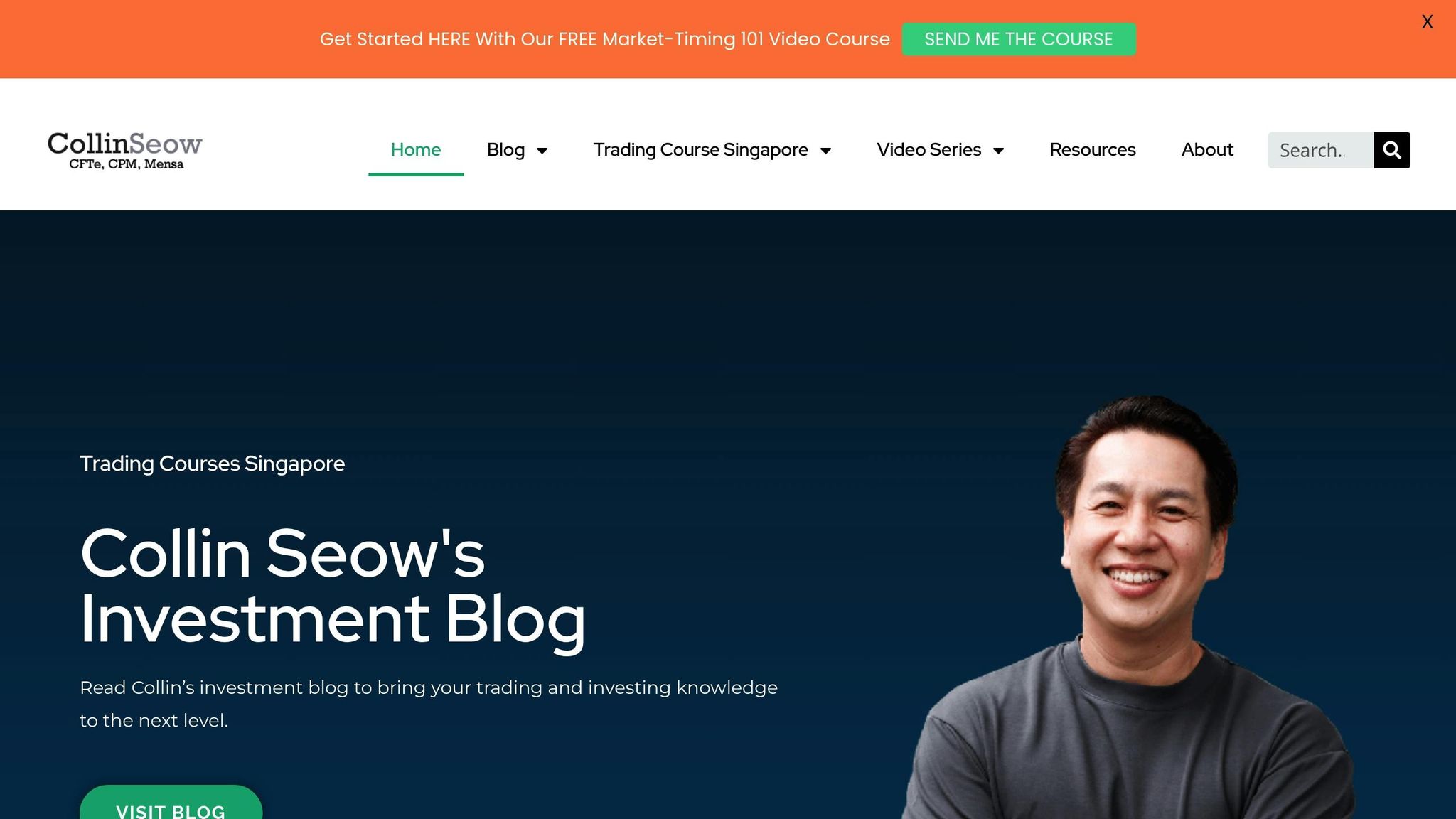Cross-asset correlation helps traders understand how different asset classes like stocks, bonds, commodities, and currencies move in relation to one another. This knowledge is critical for building diversified portfolios, managing risks, and identifying trading opportunities, especially in Singapore’s interconnected markets.
Here’s what you need to know:
- What it is: Cross-asset correlation measures how assets from different categories interact. For example, how the Straits Times Index (STI) relates to crude oil prices or USD/SGD exchange rates.
- Why it matters: It aids in portfolio diversification, reduces risk, and highlights opportunities during market shifts. For example, stocks and bonds often have negative correlations, balancing losses in one with gains in the other.
- How to measure: Use the Pearson correlation coefficient (range: -1 to +1) or rolling correlation to track relationships over time.
- Impact of macroeconomic events: Events like interest rate changes or geopolitical tensions can shift correlations, affecting asset movements.
- Trading strategies: Popular approaches include pairs trading, macro trading, and arbitrage, all leveraging correlation data for profit or risk management.
For Singapore-based traders, tools like ETFs, futures, and options can be used to apply these strategies effectively. Always monitor liquidity, position sizes, and market conditions to adapt your trades as correlations evolve.
How Cross-Asset Correlation Affects Trading
Correlation plays a key role in shaping portfolio strategies, managing risks, and identifying trading opportunities. For traders in Singapore, where markets are closely tied to global trends, these relationships can shift rapidly due to external events.
Using Correlation for Risk Management
Correlation is a valuable tool for reducing portfolio risk, especially during volatile periods. By combining assets with low or negative correlations, traders can cushion their portfolios against market downturns.
For example, consider holding positions in the STI Index alongside Singapore Government Securities (SGS bonds). When global uncertainty spikes and equities decline, bonds often rise as investors flock to safer assets. This negative correlation between stocks and bonds can help balance losses in equities with gains in bonds, stabilising the portfolio’s value in SGD terms.
However, correlations aren’t static. During periods of extreme economic uncertainty, they can shift dramatically. JP Morgan‘s research shows that heightened volatility often leads to higher correlations across markets. In such scenarios, assets that typically move independently may start moving in the same direction.
Collin Seow highlights the importance of adjusting position sizes during such times:
The question of how much to buy is central to managing investment risk. Collin’s approach emphasises strategic position sizing, which involves determining the appropriate investment amount for each trade based on an individual’s risk tolerance and the trade’s risk-reward profile.
This means traders need to adjust their exposure based on observed correlations. If correlations between holdings increase during volatile periods, reducing position sizes can help maintain the desired risk level. Conversely, when correlations weaken, increasing allocations can provide better diversification benefits.
This adaptive approach to risk management not only protects portfolios but also unveils opportunities hidden within market inefficiencies.
Finding Market Inefficiencies
Analysing correlations can uncover temporary price discrepancies between related assets – opportunities that traders can leverage. For instance, if two assets that usually move together suddenly diverge, or if assets with an inverse relationship start moving in sync, these anomalies often signal short-term trading opportunities.
Take gold and the US dollar as an example. Historically, they move inversely. If they begin moving in the same direction for a short time, this could indicate a temporary mispricing. Traders who act quickly may profit as prices revert to their usual pattern.
During the 2008 financial crisis, correlations between equities, commodities, and credit markets spiked unexpectedly. Assets that typically moved independently began moving together as market panic spread. Traders who spotted these shifts could exploit the mispricing by buying undervalued bonds while shorting overvalued equities – capitalising on the eventual return to normal correlations.
One systematic approach to these inefficiencies is the straddle technique. This involves selling the statistically higher-priced correlated asset while buying the lower-priced equivalent. This strategy works best when the correlation between the two assets exceeds 0.75 and there’s a significant price gap between them.
Before diving into such trades, it’s critical to check liquidity. Look at bid-ask spreads and trading volumes to ensure you can enter and exit positions efficiently without incurring significant slippage. Understanding what drives these inefficiencies – like liquidity constraints or trading costs – can help you decide which opportunities are worth pursuing.
These inefficiencies often evolve further when macroeconomic events disrupt asset dynamics.
How Macroeconomic Events Affect Correlations
Macroeconomic events such as interest rate changes, inflation expectations, and geopolitical tensions significantly influence asset correlations. These events shape investor sentiment and trigger portfolio rebalancing, often altering the relationships between assets.
For instance, when the US Federal Reserve raises interest rates, the US dollar tends to strengthen. This can negatively impact emerging market equities, including those in Singapore’s export-driven economy. As a result, the USD and Singapore’s equity indices may exhibit stronger negative correlations. For traders, this means a rising US dollar could weigh on STI-listed companies reliant on exports while simultaneously affecting the USD/SGD exchange rate.
Geopolitical crises can also create dramatic shifts. In times of uncertainty, investors often rush to safe-haven assets like gold and government bonds, increasing the positive correlation between these traditionally distinct asset classes. This “flight to quality” can happen quickly, compressing decision-making timeframes.
Over the last two decades, globalisation and the integration of financial markets have generally increased cross-asset correlations. Singapore, as a financial hub, is particularly sensitive to these global trends.
During these periods, hedging strategies may require adjustments. Assets that typically provide diversification might start moving in sync with your core holdings, leaving your portfolio more exposed than expected. Regular monitoring is crucial since correlations that seemed stable for months can shift within days following major economic announcements.
Research examining 1,710 futures pair portfolios across 64 liquid markets found that targeting high-performing pairs using signals like value, momentum, and carry significantly boosted returns – from 3.6% to 14.3%. This highlights how understanding macroeconomic conditions and their impact on asset relationships can enhance trading outcomes.
The takeaway? Keep your correlation analyses updated, especially during turbulent times. Combine quantitative tools with macroeconomic insights, and use stop-loss orders and position sizing to manage risks effectively when employing correlation-based strategies.
Trading Strategies Using Cross-Asset Correlations
Using cross-asset correlations can help traders uncover profit opportunities, manage risk, and take advantage of market inefficiencies. Key strategies in this realm include pairs trading, macro trading, and arbitrage. Each approach leverages correlation data in distinct ways, catering to different market scenarios and trader preferences. Let’s break down these strategies in more detail.
Pairs Trading
Pairs trading is a market-neutral strategy that relies on mean reversion. The idea is simple: find two assets with a strong historical correlation. When their price relationship deviates, you go long on the undervalued asset and short the overvalued one. As the spread between the two assets narrows, profits are realised.
The success of this strategy hinges on selecting the right pairs. Traders often focus on assets with correlation coefficients above 0.75 and use cointegration tests to confirm that the relationship is statistically sound. For instance, a trader might pair Singapore-listed bank stocks with regional real estate investment trusts (REITs) if historical data shows their prices typically move together. If bank stocks rally while REITs lag, the trader could short the bank stock and buy the REIT, anticipating a return to the usual price relationship.
Research by Alpha Architect, which analysed 64 liquid futures and forwards markets (spanning equities, bonds, currencies, and commodities), revealed that systematic signals like value, momentum, and carry can significantly boost returns – from 3.6% to 14.3%. While pairs trading helps reduce exposure to broad market swings, correlations can break down during high-volatility periods. To mitigate risks, traders should set tight stop-losses and continuously monitor the relationship between their chosen pairs.
Macro Trading
Unlike pairs trading, which focuses on mean reversion, macro trading capitalises on broader economic trends. This strategy involves positioning based on shifts in asset correlations caused by factors like economic policies, geopolitical developments, or central bank actions.
For example, if policy changes strengthen the Singapore dollar (SGD), export-sensitive equities might suffer. A macro trader could short these equities while going long on the SGD, aiming to benefit from both the currency’s appreciation and the equities’ decline.
Interest rate changes provide another opportunity. When the US Federal Reserve raises rates, the US dollar often strengthens, creating negative correlations with emerging market equities and commodities priced in USD. JP Morgan’s research highlights that during periods of heightened market volatility, cross-market correlations tend to increase significantly. Recognising such patterns can help traders adjust their positions to align with evolving market conditions.
Arbitrage Opportunities
Arbitrage strategies take advantage of temporary mispricing between correlated assets to secure low-risk profits. The approach involves buying the undervalued asset and selling the overvalued one, expecting prices to converge.
Consider gold as an example. Occasionally, gold prices quoted in Singapore dollars may deviate from global gold prices when adjusted for the USD/SGD exchange rate. A trader could buy gold locally at a lower price and sell it in a market with higher prices, locking in a profit as the prices align. However, these opportunities are short-lived, often disappearing as more traders step in. Speed and access to real-time data are critical for success.
Liquidity and transaction costs also play a significant role in arbitrage. While assets like the Straits Times Index (STI), SGD, and major commodities are generally liquid in Singapore, some cross-asset pairs may face wider bid-ask spreads or lower trading volumes, increasing execution risk. Additionally, brokerage fees, exchange charges, and currency conversion costs can eat into already thin arbitrage margins.
Key Takeaways for Risk Management
Across all three strategies – pairs trading, macro trading, and arbitrage – effective risk management is non-negotiable. Traders should:
- Set appropriate stop-loss orders.
- Carefully size their positions.
- Regularly update correlation models, as historical relationships can shift during market stress.
Research suggests that cross-asset straddle trades perform best when the correlation coefficient between assets exceeds 0.75. Below this level, the likelihood of mean reversion drops, making it crucial to continuously monitor correlation metrics and adapt to changing market dynamics.
Master Systematic Trading with Collin Seow
Learn proven trading strategies, improve your market timing, and achieve financial success with our expert-led courses and resources.
sbb-itb-466c9b0
Tools and Methods for Analysing Cross-Asset Correlations
Analysing cross-asset correlations requires a structured approach to assess relationships, manage risks effectively, and execute trades with precision. Building on earlier techniques, the following tools and methods can enhance your cross-asset analysis.
Statistical and Quantitative Methods
To delve deeper into cross-asset analysis, advanced statistical techniques go beyond basic correlation measurements. The correlation coefficient, a key metric in this field, helps traders identify strong relationships, particularly those above 0.75. This threshold is often used in strategies like straddle or pairs trading, as it suggests a robust connection between asset prices that can be exploited for profit. A negative correlation between stocks and bonds is especially valuable for portfolio diversification; when stocks dip, bonds often rise, acting as a natural hedge.
Calculating correlation coefficients is relatively simple. Traders typically use tools like Excel or Google Sheets to analyse historical price or return data. However, this method has its limits – it only captures linear relationships and cannot distinguish between short-term price movements and long-term trends.
To address this, cointegration tests are employed. These tests identify whether two assets maintain a stable long-term relationship despite short-term price fluctuations. This distinction is crucial for mean-reversion strategies, as a high correlation coefficient might only reflect temporary market conditions. Cointegration, on the other hand, highlights assets likely to revert to their historical relationships, helping traders focus on genuine opportunities and avoid misleading signals.
Another useful tool is Z-score normalisation, which standardises price movements by calculating how many standard deviations an asset’s price deviates from its historical mean. In pairs trading, Z-scores help pinpoint significant price divergences. For instance, when price spreads exceed 2–3 standard deviations, it could signal a potential mean-reversion opportunity.
Research on 1,710 futures pair portfolios across 64 liquid markets – including equities, bonds, currencies, and commodities – demonstrates the effectiveness of systematic approaches. By targeting high-performing pairs using value, momentum, and carry signals, equity value returns increased from 3.6% to 14.3%.
Trading Instruments for Cross-Asset Strategies
Choosing the right trading instruments is essential for a successful cross-asset strategy. Common options include Exchange-Traded Funds (ETFs), futures contracts, and options, each suited to different objectives and timeframes.
- ETFs: These offer broad exposure to multiple asset classes at relatively low costs. They are ideal for macro strategies, providing diversified access to sectors, regions, or asset classes. For Singapore-based traders, ETFs tracking the Straits Times Index (STI), regional equity markets, or commodity baskets offer a straightforward way to explore cross-asset opportunities without managing individual positions.
- Futures contracts: These provide leverage, enabling traders to control larger positions with less capital. Futures are particularly effective for pairs trading and arbitrage strategies, as they allow simultaneous long and short positions with minimal transaction costs. Their standardised nature also makes execution more straightforward.
- Options: Options offer flexibility and precise risk management through premium payments. While they require a deeper understanding of pricing dynamics, they are valuable for expressing views on correlation changes or hedging specific risks.
The choice of instrument depends on your strategy. Futures are preferred for pairs trading due to their efficiency and liquidity, while ETFs are better suited for broader diversification in macro strategies. Arbitrage opportunities often call for a mix of instruments to capture fleeting price discrepancies.
Regardless of the instrument, bid-ask spreads and trading volume play a crucial role in execution quality. Narrow spreads indicate liquid markets where trades can be executed efficiently, while wider spreads suggest lower liquidity and higher transaction costs. This is especially important in arbitrage strategies, where thin margins can be quickly eroded.
Risk Management Basics
Effective risk management is the backbone of any cross-asset strategy. Even the most advanced correlation analysis won’t matter without safeguards in place. Trading correlated assets carries unique risks, particularly the chance that correlations break down when they’re needed most.
- Position sizing: This requires careful planning, as correlated assets can move in tandem, amplifying losses if correlations fail. Positions should be sized based on both correlation strength and asset volatility. For pairs trading, equal-dollar or equal-volatility sizing ensures balanced profits and losses between the two assets.
- Stop-loss orders: These are critical for guarding against unexpected correlation breakdowns. For instance, in a pairs trade, a stop-loss might trigger if the price spread between two assets widens beyond a set threshold, such as 3-4 standard deviations. Portfolio-level stop-losses can also be implemented to exit all correlation-based trades if overall losses exceed acceptable limits.
- Monitor liquidity: Liquidity is a key factor in cross-asset trading. Evaluate metrics like market depth, trading volume, and bid-ask spreads. During periods of market stress, liquidity can evaporate quickly, leading to slippage – the difference between expected and actual execution prices – which can erode profitability. Prioritise assets with high trading volumes and tight spreads to ensure efficient trade execution, particularly for Singapore-based traders navigating regional markets with varying liquidity profiles.
Learning Resources for Cross-Asset Correlation
Gaining expertise in cross-asset correlation isn’t a one-time task – it’s a journey. With the right resources, you can move from understanding the basics to confidently applying advanced trading strategies.
Learning with Collin Seow Trading Academy

Structured education is crucial for putting cross-asset correlation strategies into practice. At Collin Seow Trading Academy, traders can learn disciplined, systematic trading techniques through courses, free e-courses, and live webinars that focus on applying correlation analysis effectively.
One standout offering is the academy’s newly launched e-course on cross-asset correlation analysis, which saw 1,200 enrolments in its first month. This course dives into statistical methods, trading instruments, and risk management – all essential for using correlation-based strategies. What makes it especially relevant for traders in Singapore is its local case studies, ensuring that the lessons can be directly applied to Singapore’s market landscape.
For beginners, the Market Timing 101 E-Course is a great way to get started. It’s free and offers an introduction to systematic trading. For those ready to take their skills further, the Systematic Trading Profits programme introduces a 3-Phase Growth System that teaches traders how to determine what to buy, when to buy, and how much to buy. These principles can be directly adapted to cross-asset correlation strategies.
Live webinars are another key feature of the academy. These sessions let participants interact with instructors, ask questions about specific scenarios, and see real-time analysis of both Singapore and regional markets. This hands-on approach helps bridge the gap between theory and practice, especially when dealing with the complex relationships between various asset classes.
Books and Video Content
Books are a great way to build a strong foundation in correlation analysis. One must-read is ‘The Systematic Trader v.2’ by Collin Seow. Known for its practical approach, the book simplifies complex topics like cross-asset correlation and systematic trading. It even earned a spot on the Financial Times‘ list of top trading books for 2023, with readers praising its clear explanations and actionable steps.
The book’s insights go beyond traditional stock–bond relationships, covering strategies for options, cryptocurrencies, and other asset classes. This broad perspective is especially useful for Singapore-based traders who often participate in a variety of markets, including equities, commodities, and digital assets.
For those who prefer visual learning, the academy offers free video content that demonstrates correlation analysis techniques. These videos feature real-world examples from Singapore and regional markets, covering everything from market trends to trading strategies. Seeing these concepts applied to actual data can make it easier to implement them in your own trades.
The combination of books and videos creates a well-rounded learning experience. While books provide detailed, in-depth material, videos bring the concepts to life by showing how they play out in dynamic market conditions.
The Value of Mentorship
While resources like books and courses are essential, mentorship is what transforms knowledge into consistent trading success. Having a mentor can refine your strategies and help you avoid common mistakes, like relying too heavily on historical correlations. A 2023 survey by the CFA Institute revealed that 78% of professional traders consider correlation analysis a critical skill for risk management and portfolio diversification. However, many struggle to apply it effectively without guidance.
At Collin Seow Trading Academy, mentorship programmes offer personalised feedback on trading strategies. With over 13 years of market experience and certifications like Chartered Portfolio Manager (CPM) and Certified Financial Technician (CFTe), Collin Seow brings a wealth of expertise to his mentorship sessions. His book, Secrets of Highly Profitable Traders, was even featured as a 24-week national bestseller in The Straits Times, cementing his reputation within Singapore’s trading community.
The academy also fosters peer learning through its community forums. These platforms allow traders to discuss specific correlation scenarios, share insights on Singapore’s market trends, and learn from each other’s experiences with strategies like pairs trading and macro analysis. This collaborative environment accelerates learning and helps solidify advanced trading concepts.
Live Q&A sessions during webinars provide immediate answers to pressing questions. Whether you’re unsure about position sizing in a pairs trade or need help interpreting correlation coefficients during volatile market conditions, these sessions offer real-time support from experienced instructors.
The academy’s resources have received strong praise, with its live webinars and e-courses averaging a 4.6/5 rating on Trustpilot. Many users highlight the quality of mentorship and the supportive community as standout features. By combining structured courses, practical tools, and ongoing support, the academy creates an ideal environment for mastering cross-asset correlation techniques – helping traders move from basic understanding to confident execution.
Conclusion
Key Takeaways
Cross-asset correlation plays a crucial role in shaping risk management, portfolio construction, and identifying trading opportunities. By understanding how different asset classes interact, traders gain a valuable advantage in navigating the complexities of today’s interconnected markets.
Correlation coefficients, which range from –1.0 to +1.0, serve as a direct guide for making informed trading decisions. For instance, the traditional inverse relationship between stocks and bonds has historically provided investors with a reliable hedge during times of market stress. A study of 1,710 futures pair portfolios revealed that equity value returns surged from 3.6% to 14.3% when strategies focused on high-performing cross-asset pairs were applied.
However, correlations are not fixed. During periods of macroeconomic uncertainty or heightened market volatility, correlations between asset classes often increase. This synchronisation – where equities, commodities, and bonds are sold off simultaneously – can undermine diversification benefits when they’re needed most. Recognising these shifts and adjusting strategies accordingly is key to long-term success.
The practical applications of cross-asset correlation are vast. Whether you’re employing pairs trading, seizing relative value opportunities, or building macro-driven portfolios, a strong grasp of correlations is essential. Combining statistical analysis with strict risk controls – such as monitoring market depth and liquidity – ensures more informed and effective decision-making.
With these insights in hand, it’s time to move from theory to practice.
Next Steps for Traders
Now that you’ve gained a deeper understanding of cross-asset correlation, it’s time to put these concepts into action. A disciplined approach is essential for successful implementation.
For structured learning, explore the resources at Collin Seow Trading Academy, which caters to traders at all levels. Beginners can start with the Market Timing 101 E-Course, a free introduction to systematic trading principles. For more advanced traders, the Systematic Trading Profits programme provides a comprehensive framework, teaching the 3-Phase Growth System. This system covers key aspects such as what to buy (using comparative strength analysis), when to buy (leveraging technical analysis and market timing), and how much to buy (through strategic position sizing for risk management).
The academy also offers a new e-course focused on cross-asset correlation analysis, featuring case studies tailored to Singapore’s market environment. For further insights, The Systematic Trader v.2 by Collin Seow provides detailed strategies across asset classes, including options and cryptocurrencies. The book outlines practical steps for generating consistent income streams and creating customised options strategies.
To sharpen your skills, participate in live webinars and join community forums where traders share real-time market analysis and strategies. Such interactions can deepen your understanding and enhance your ability to apply these concepts effectively.
Don’t forget to regularly update your correlation analysis as market conditions evolve. Strategies that perform well during stable periods may require adjustments in times of volatility. Stay informed with free investing and trading videos, and keep an eye on market insights to identify emerging trends and shifts in correlation patterns.
Transitioning from learning to executing cross-asset correlation strategies requires dedication. Whether your goal is to manage risk, uncover arbitrage opportunities, or build a diversified portfolio, the systematic approach taught at Collin Seow Trading Academy provides a reliable framework for success. Start today by exploring the free resources available and laying the groundwork for long-term trading achievement.
FAQs
How can traders in Singapore use cross-asset correlations to manage risk during market volatility?
Traders in Singapore can tap into cross-asset correlations to manage risk more effectively by observing how various asset classes – like equities, bonds, and commodities – interact. For example, during periods of market turbulence, some assets may move in opposite directions, creating opportunities to diversify and reduce risk.
By studying these relationships, traders can design portfolios that strike a balance between risk and reward. For instance, if stock prices decline, bond prices might rise, potentially offsetting losses. Keeping track of correlation trends and reviewing your portfolio regularly ensures it stays aligned with both your risk tolerance and the current market landscape.
For those wanting to expand their knowledge, platforms such as Collin Seow Trading Academy provide resources to help traders craft systematic strategies and make well-informed decisions in ever-changing markets.
What are the key signs that asset correlations might shift due to macroeconomic events?
Asset correlations can shift dramatically during major macroeconomic events, and understanding key indicators can help traders fine-tune their strategies. For instance, major economic announcements – like interest rate decisions, GDP releases, or inflation reports – often trigger changes in correlations as markets digest new information. Likewise, geopolitical events, such as trade agreements or conflicts, can alter how various asset classes interact.
Another crucial element is market sentiment. In times of uncertainty, such as during a financial crisis, assets that are typically uncorrelated may start moving in tandem as investors gravitate toward safer investments. Keeping an eye on these factors allows traders to anticipate and adjust to shifts in asset correlations more effectively.
How can ETFs, futures, and options help traders leverage cross-asset correlations?
ETFs, futures, and options are versatile financial instruments that help traders navigate cross-asset correlations while diversifying their portfolios and managing risk. ETFs, for example, give traders access to a collection of assets, making it simpler to observe how different asset classes move in relation to one another. Futures contracts allow traders to speculate on or hedge against price changes across various markets, while options provide the flexibility to benefit from both upward and downward price movements.
Grasping how these tools interact with cross-asset correlations equips traders to make smarter decisions and adjust their strategies based on market dynamics. For those keen on expanding their expertise, platforms like Collin Seow Trading Academy offer resources to better understand these concepts and enhance systematic trading techniques.












